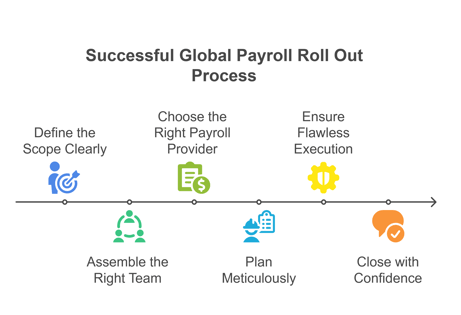In today’s dynamic business environment, organizations are increasingly pursuing payroll transformation—not just to keep up with statutory changes or technology upgrades, but to streamline global operations and enhance employee experience. A successful global payroll rollout is at the heart of this transformation, requiring more than just system changes or vendor swaps; it’s a strategic change management initiative that demands precision, coordination, and trust.
Having led multiple enterprise transformation projects over the past 20+ years, including complex global payroll rollouts, I’ve seen what works and what doesn’t. Here’s a practical blueprint drawn from real-world experience to help organizations succeed in their payroll journey.

1. Define the Scope Clearly: The “What”
This is the foundation of a successful global payroll rollout. Organizations must define what they want out of the payroll transformation before diving in.. Key considerations include:
- Are we retaining the existing HR system, or rolling out a new one?
- Will payroll be processed in-house or outsourced to a vendor?
- Should we adopt a cloud-based platform or keep it on-premises?
Without clarity at this stage, downstream activities in the global payroll rollout often derail.
2. Assemble the Right Team: The “How”
Once the scope is defined, build a core team of experts who not only understand payroll intricacies but also embrace change. This cross-functional team is critical for driving a smooth global payroll rollout and should include:
- HR and Payroll Experts
- IT Specialists
- Change Management Professionals
- Project Managers with transformation experience
The team should have both technical competence and the empathy to handle employee-facing changes smoothly.
3. Choose the Right Payroll Provider
This is not just a technology partner—it's a long-term collaborator.
Choose a provider with proven success stories that match your scale and complexity. They must excel in two areas:
- System Implementation: Set up the right infrastructure, workflows, and integrations.
- BAU Operations: Ensure ongoing compliance, timely processing, and employee satisfaction.
Look for a provider who can demonstrate consistency beyond go-live.
4. Plan Meticulously: From Discovery to Deployment
Effective planning can make or break the transformation. Key project milestones to track:
- Solution Finalization: Map the current (AS-IS) and future (TO-BE) processes.
- Engineering Timelines: Avoid over-customization to reduce maintenance risk.
- User Acceptance Testing (UAT): Set clear acceptance criteria in advance.
- Data Readiness: Validate, cleanse, and share master and transactional data early.
- Parallel Runs: Ensure full reconciliation between legacy and new payroll systems during the global payroll rollout.
- Go-Live Readiness: Train users well, especially for Employee Self-Service (ESS) functions. In some countries (e.g., India), Flexi Benefits enrolment through ESS is critical.
5. Ensure Flawless Execution
Execution is where good plans become reality—or fall apart. Here’s how to stay on track:
- Project Governance: Weekly status meetings and monthly Steering Committee reviews are essential.
- Proactive Risk Monitoring: Keep a live risk register and review it regularly.
- Change Management: Control scope creep through a formal Change Control Board. Every change should be assessed for its impact on cost, scope, and timelines.
6. Close with Confidence
Project closure is often underestimated, but crucial.
- Ensure smooth transition from implementation to support teams.
- Track and close all pending implementation items.
- Review contractual obligations to avoid last-minute surprises.
- Conduct a lesson learned session to capture knowledge for future rollouts.
In Conclusion
A successful global payroll rollout delivers more than automation—it builds trust within the organization. When employees know their pay is accurate, timely, and transparent, it contributes to satisfaction, retention, and peace of mind.
Leading or planning a global payroll rollout?
Just a reminder: it’s not only about the technology - it’s about driving a true payroll transformation for long-term success.






